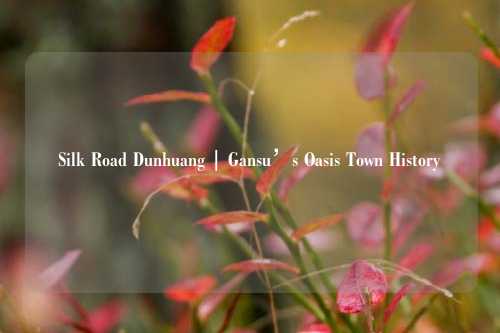Silk Road Dunhuang | Gansu’s Oasis Town History
Dunhuang, located in the western part of China, is an enchanting city with a deep historical and cultural heritage. Situated at the edge of the vast Gobi Desert, this city served as an important stop along the ancient Silk Road, a network of trade routes that connected China to Central Asia, the Middle East, and beyond. Over the centuries, Dunhuang has grown into a treasure trove of ancient architecture, art, and culture, attracting scholars, tourists, and history enthusiasts from around the world.
Rich History and Strategic Importance
Dunhuang’s history can be traced back over two thousand years, making it one of the oldest cities in China. The city’s strategic location made it a vital link between the Chinese Empire and the distant lands of Central Asia. This position on the Silk Road facilitated the exchange of goods, culture, and ideas, and Dunhuang became a bustling commercial hub. Merchants and travelers passed through the city, bringing with them exotic spices, textiles, and artworks, while carrying Chinese silk, porcelain, and tea to foreign lands. As a result, Dunhuang was a melting pot of cultures, blending elements of Chinese, Persian, Indian, and Greco-Roman influences.

The Mogao Caves: A Glimpse into Ancient Art
One of the most significant attractions in Dunhuang is the Mogao Caves, a UNESCO World Heritage site. The caves, also known as the Dunhuang Caves, are a network of 492 Buddhist cave temples carved into the cliffs of the Mingsha Mountain. These caves, which date back to the 4th century, are home to thousands of Buddhist murals, statues, and manuscripts. They provide a rare and invaluable glimpse into the spiritual and artistic life of ancient China, as well as the cultural exchanges that occurred along the Silk Road.
The murals and sculptures within the caves depict scenes from the life of the Buddha, as well as historical and mythological figures. These works of art showcase the evolution of Chinese Buddhist art over several centuries, and their vibrant colors and intricate details are a testament to the skill and dedication of the artists who created them. In addition to the visual art, the Mogao Caves also contain a vast collection of ancient manuscripts, including religious texts, medical treatises, and historical documents. The discovery of the Dunhuang Manuscripts in the early 20th century provided scholars with a wealth of knowledge about the ancient world and the diverse cultures that once flourished along the Silk Road.
The Crescent Moon Spring and the Echoing Sand Mountain
Another famous landmark near Dunhuang is the Crescent Moon Spring, located at the base of the Echoing Sand Mountain. This natural spring, which has been a source of water in the arid desert for centuries, is surrounded by a crescent-shaped sand dune, giving it its unique name. The spring is an oasis in the desert, and its clear waters have been a vital resource for travelers along the Silk Road. The surrounding Echoing Sand Mountain is known for the sound that the sand makes when it shifts in the wind, which can resemble the sound of a drum or a trumpet.
Visitors to this area can enjoy a breathtaking view of the desert landscape, where the golden sand dunes stretch endlessly into the horizon. The contrast between the lush greenery surrounding the Crescent Moon Spring and the barren expanse of the desert is a striking sight, making it one of the most picturesque locations in the region.
Dunhuang’s Role in Buddhism and Cultural Exchange
Dunhuang played a crucial role in the spread of Buddhism from India to China. The city’s location at the crossroads of various trade routes made it a natural center for religious and cultural exchange. Buddhist monks and travelers from India, Central Asia, and China passed through Dunhuang, bringing with them new teachings, texts, and artworks. As a result, Dunhuang became a major center of Buddhist learning and practice, with numerous temples and monasteries built to accommodate the growing number of monks and pilgrims.
The city’s significance in the history of Buddhism is reflected in the numerous Buddhist sites found throughout the region, including the Mogao Caves, the Yulin Caves, and the Western Thousand Buddha Caves. These sites are not only important for their religious and historical value but also for their artistic and cultural significance. The murals and sculptures found in these caves offer a unique insight into the evolution of Buddhist art and the way in which Buddhist teachings were interpreted and adapted to different cultural contexts.
Dunhuang’s Modern Legacy and Tourism
Today, Dunhuang continues to attract visitors from around the world who come to experience its rich history and vibrant cultural heritage. The city is a popular destination for tourists interested in exploring the Silk Road and learning about the ancient cultures that once thrived along its routes. In addition to the Mogao Caves, visitors can explore other historic sites in the area, including the Dunhuang Museum, the ancient city ruins of Jiaohe, and the nearby towns of Turpan and Jiayuguan.
Dunhuang also serves as a gateway for travelers heading into the Gobi Desert, where they can explore the vast and untamed wilderness that stretches across northern China and Mongolia. The desert landscape, with its towering sand dunes, rocky outcrops, and unique wildlife, offers a striking contrast to the bustling city life, making it a must-see destination for adventurers and nature lovers.
A City of Artistic and Cultural Significance
Dunhuang’s significance as a center of art, culture, and religion cannot be overstated. The city’s unique blend of Chinese, Central Asian, and Buddhist influences has left an indelible mark on its architecture, art, and traditions. The murals and sculptures found in the Mogao Caves are among the finest examples of Buddhist art in the world, and the city’s role in the transmission of religious and cultural ideas along the Silk Road has had a lasting impact on the development of East Asian civilization.
Moreover, Dunhuang's importance goes beyond its historical and cultural legacy. The city stands as a symbol of the enduring connections between East and West, and the city’s rich heritage continues to inspire artists, scholars, and travelers alike. The preservation of the Mogao Caves and other historical sites in the region is essential not only for understanding China’s past but also for fostering a greater appreciation of the shared human history that connects people from all corners of the globe.
Conclusion
Dunhuang is much more than a stop on the ancient Silk Road. It is a city that offers a window into the rich cultural, religious, and artistic heritage of China and the world. From the awe-inspiring Mogao Caves to the serene beauty of the Crescent Moon Spring, Dunhuang is a place where history, art, and nature converge. For those seeking to explore the ancient world and experience the timeless beauty of the desert, Dunhuang stands as a destination of unparalleled significance.
















